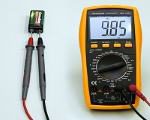From time to time it is necessary to check the car battery, as the operation of the car depends on it. You can check the battery different methods and devices, one of which is a multimeter. This device is a universal device that will always come in handy both at home and in the kit of any motorist. And for those people who do not yet know how to check the battery with a multimeter, this article will come in handy. Below I will tell you how to properly check the capacity and charge of a car battery.
Modern manufacturers of automotive power supplies complete their products with a sensor that shows the amount of charge by changing colors. This, of course, is convenient. But in order to make sure that the battery charging is true, you can use the old, proven method - diagnostics with a multimeter. It is also used when you need to check the energy source without a special sensor. Checking with this measuring device consists in determining the voltage at the terminals. If the display of the device shows 12.6 V as a result of measurement, this indicates that the battery is fully charged. When there are other indications on the same board, for example, 12.2 V, this means that the battery is partially discharged and it would not hurt to recharge it. If the multimeter shows numbers less than twelve, then it is completely discharged and must be charged urgently. It must be remembered that the readings of the device below the mark of eleven are very critical for both the power supply and the car. Such figures indicate that it is already unattended and cannot be operated. Otherwise, you risk damaging the vehicle and burning out the charger or alternator.
Car battery test steps:
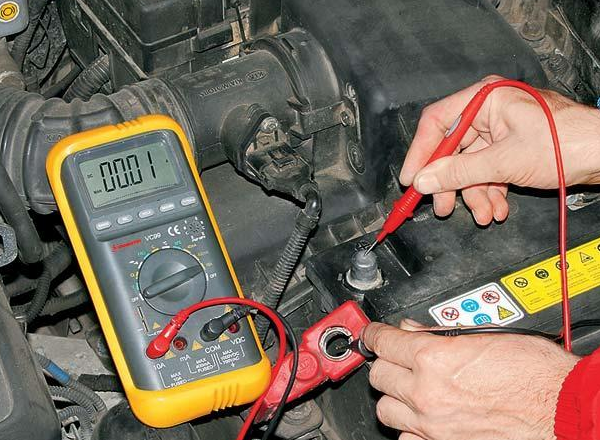
Based on the data from the screen of the multimeter, we can conclude in what position the charge of the device is.
How to check capacity?
A little about the capacity of the car. This characteristic of a car battery shows how much charge a power source will give in a certain period of time at a certain voltage. This characteristic is measured in ampere-hours. The capacity of a car battery can be checked in several ways.
Consider how to check the battery capacity. For this method, you need to stock up on the multimeter itself, and we also need a load. If we can see the capacity in the passport, then the load must be calculated. We need to pick up such a load that it would take half the battery current. If the capacity is 7A / h, then we need to pick up something with a load of 3.5 V. Let's take a lamp from a car headlight, the power of which is 35-40 W (it is best to use a light bulb, then you will understand). The first step is to connect the load. After that, wait a couple of minutes.
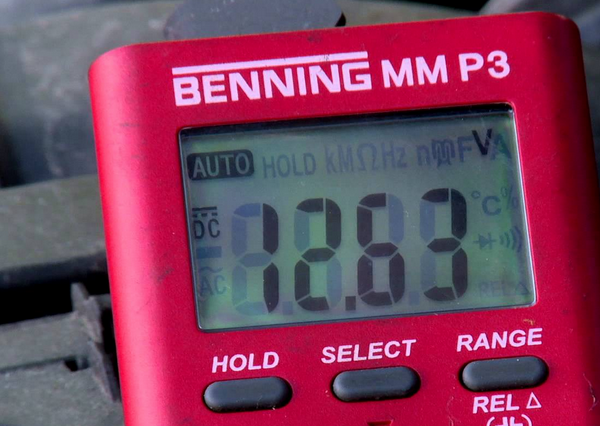
In the event that a light bulb is selected as the load, it may gradually dim during the test. This is a clear sign that it is unattended and that the check can be completed.
But, in the event that this did not happen, you can find out the voltage at the terminals and at the same time not turn off the load. Results on the scoreboard in the range of 12.4 and above indicate that the capacity is full and the battery is working. So, if you have problems starting, then look for problems in other auto systems. The capacity is considered low if the multimeter shows 12 - 12.4 V. With such readings, it will not last long, which means that it's time to think about purchasing a new car power source.
The capacity of the power supply can be measured with more modern devices, and therefore more efficiently. The operation of these devices is to supply special signals to the battery. Such devices are indispensable assistants for the driver. Since by measuring the battery with these devices, you can get accurate readings. And for this you do not need to disconnect it from the car. The advantage is that they are compact, during operation they do not make any changes to the electronics of the car. 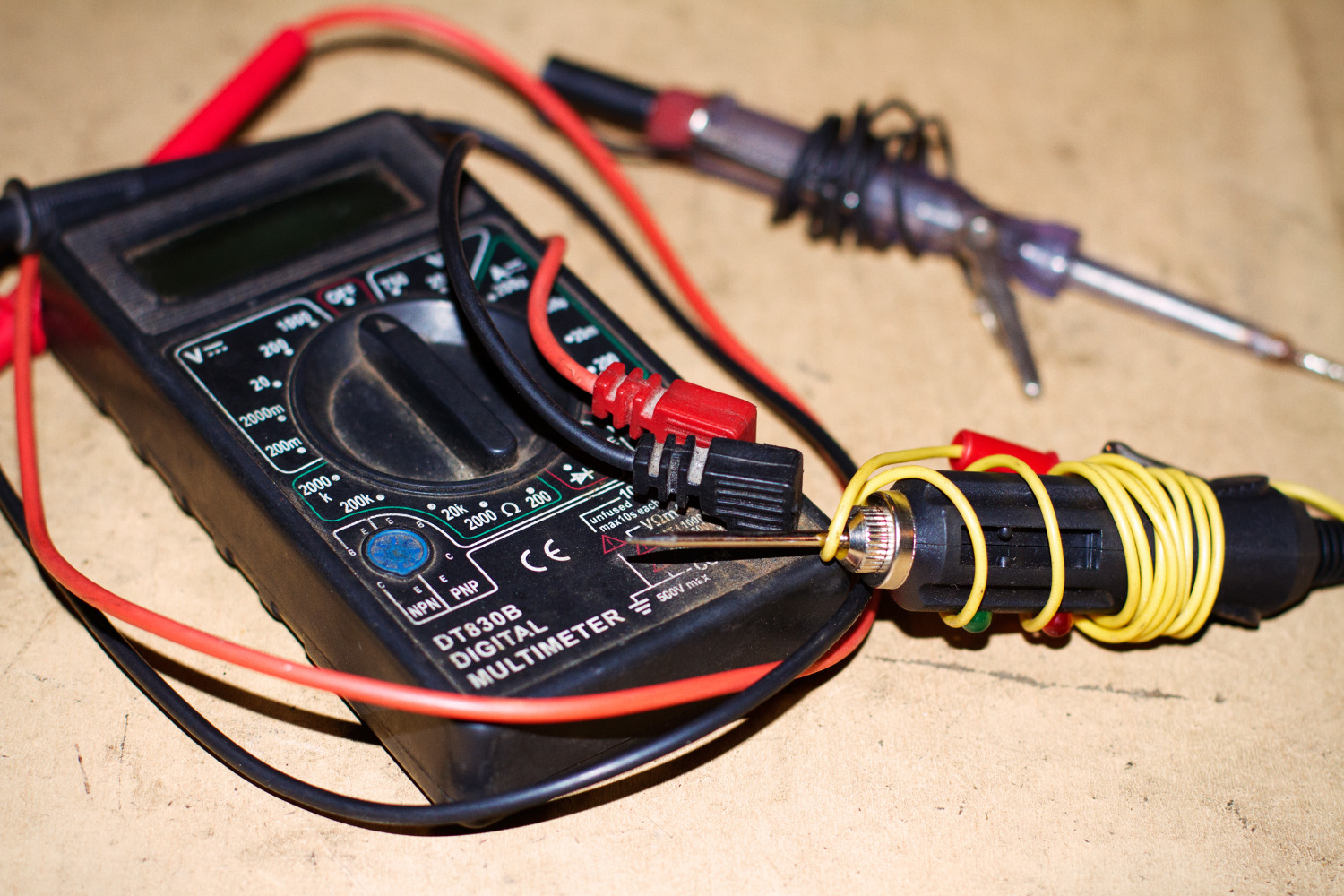 A few tips before buying a power supply. Before buying a power source for a car, you need to study it. Initially, it is necessary to make a visual inspection for damage (these are not empty words, because they are often sold with defects). The second thing you should do is to measure the density of its electrolytes yourself or with the help of a seller. The normal density should be 0.03 g/cm³ (corresponding to eighty percent of the battery charge). The final check must be performed - the data must be at least 12.5 without load, and with load must not be below 11 V after checking for five seconds.
A few tips before buying a power supply. Before buying a power source for a car, you need to study it. Initially, it is necessary to make a visual inspection for damage (these are not empty words, because they are often sold with defects). The second thing you should do is to measure the density of its electrolytes yourself or with the help of a seller. The normal density should be 0.03 g/cm³ (corresponding to eighty percent of the battery charge). The final check must be performed - the data must be at least 12.5 without load, and with load must not be below 11 V after checking for five seconds.
I recommend at least occasionally diagnosing the power supply. You can find out its characteristics using various measuring instruments, considering that there are enough of them today. They are easy to use, so there should be no issues in the work.
Video "Checking the battery with a multimeter"
The recording shows how easy it is to check a car battery.
Long-term operation of the car leads to the failure of some of its parts. The battery is no exception in this regard. Its replacement occurs at different intervals, which depends on the conditions and frequency of operation of the car. But car owners often face the question of how to check the battery? That is, for example, after four or five years of operation, in what condition it is. Will he let you down at the wrong time?
Ways to determine the technical condition of the battery
If several ways to determine the condition of the battery. Basically, special devices are used for this, which the owner of the car may not have available. Although these devices can be purchased at any store, and they are inexpensive. But what needs to be done first of all is to pay attention to the external state of the unit. It itself must be clean (or kept clean), the terminals must not be covered with a corrosive coating.
Simple Ways
The easiest way is to check the temperature of the battery. If it gets very hot, it means that the partitions between the sections are broken inside it. That is, the sections become closed. No one can fix this, so the right decision is to replace the old device with a new one.
The second option is to create a load on the battery that will be equal to half the capacity of the installation. For example, a battery with a capacity of 60 amps, which means that it will need to be connected to a load equal to about 30 amps or a little higher. What can be used for this. There are a lot of options, one of them is to connect six or seven dipped beam bulbs in parallel. Each of them creates a load of 4.5 amperes.
Now we connect this circuit to the battery terminals, observing the polarity. Obviously the lights are on. In this state, they should stand for five minutes. If the brightness of the chain does not change, then the battery device is in good condition. If they begin to gradually reduce the brightness, then the battery is not charging well.
Instrumental methods of measurement
There are several devices with which you can measure the capacity of the battery. The first is a multimeter (tester). It measures the voltage between the terminals.
Attention! Checking the battery with a multimeter should be carried out in the morning, so to speak, on cold appliance before starting the engine. The mode is set to direct current.
After measurement, you need to check the result. This is what you might end up with:
- If the check by the tester showed 12.6-12.9 volts, then your battery is one hundred percent charged. Its technical condition is excellent.
- If the readings range from 12.3 to 12.6 volts, then the battery is 75% charged.
- If the multimeter shows 12.1-12.3 V, then the capacitance is half of the maximum level.
- 11.8-12.1 V is only 25%.
- 11.5-11.8 is a completely discharged battery.
Experts note that checking the battery with a multimeter is an inaccurate determination of the state of the battery. Therefore, there are other more accurate methods.
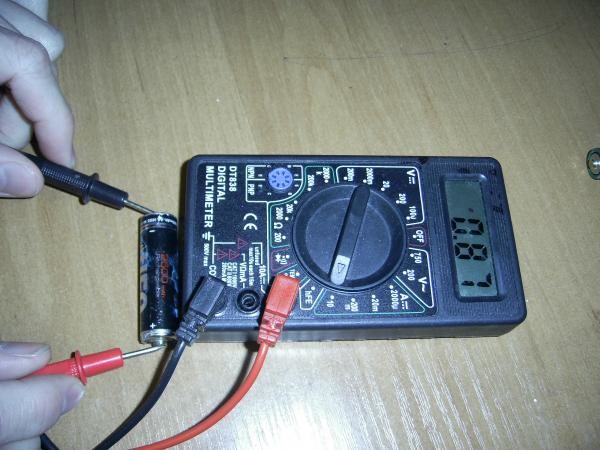
First of all, charging is determined by the density of the filled electrolyte. To check this method, you will need a hydrometer, which is very similar to an alcoholometer. That is, it is a float that is placed in a liquid, the level of its immersion determines the density of the solution. For testing, you will need to drain some electrolyte from the battery into a small container and place a hydrometer in it. Pay attention to the fact that batteries of different models have different electrolyte densities, so you should read the instructions before testing.
So, this is what should happen during the verification process:
- The electrolyte being poured itself has a density of 1.26.
- If the measurements showed a value from 1.27 to 1.29, then this is a 100% charge.
- 1.23-1.25 is a 70% charge.
- 1.11-1.13 is zero.
And another device with which you can test the condition of the battery is a load plug. In fact, this is an ordinary voltmeter with a load in the form of resistance.
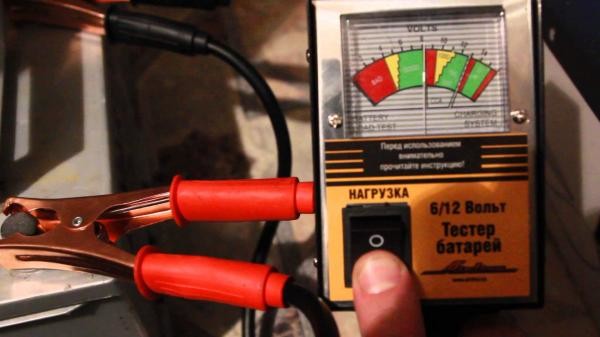
Everything is very simple here. It is necessary to connect the ends of the plug to the battery terminals, observing the polarity of the connection. After that, the terminals are loaded. Its action should not exceed five seconds. At the end of the measurement, a reading is taken. If it is at least 9 volts, then your battery is in excellent condition. But keep in mind that it is often not worth checking with a load fork. A load equal to starting the engine may reduce the capacity of the unit. And one more thing - in the process of connecting the plug to the terminals, sparking may occur. There's nothing wrong with that, really. The battery is immediately connected to the load.
Conclusion on the topic
So, we tried in this article to answer the question of how to check the battery different ways? Of course, which way to choose, everyone decides for himself. But it is better if a specialist will deal with this, who will not only check it, but also recharge the device as needed.
Related posts:
Battery voltage test
In order to check the battery voltage with a multimeter, you need to do a few simple steps:
- Not forget switch multimeter mode to voltage (measure U). Not to be confused with the concept of "amperage".
- Put amplitude voltage 0 to 20 V;
- Disconnect the battery from the car wiring .
- Red wire with probe join to the positive terminal battery.
- Black wire with probe join to negative terminal battery.
- Look at the scoreboard multimeter and remember the readings.
It is important to keep in mind that the readings taken indicate the voltage of the battery at rest. Moreover, for their maximum accuracy, it is recommended to measure U on the battery with a multimeter after the car has been at rest for 5-6 hours.
Battery capacity tests
The concept of battery capacity means how long it can work with the optimal return of a certain amount of charge at certain U values. The capacity is measured in ampere-hours, and each battery, as a rule, has indicators of its nominal capacity. The most common way to check the capacity level of a battery is to use a specific load on it.
It would be best to use the load by temporarily unscrewing the car headlight, because the headlight has a power of 35-40 watts that is suitable in all respects. This means that the headlight, when connected to the battery, will take the required half of the current so that you can find out if the battery capacity is normal. If the headlight goes out quickly, then the capacity in the battery, unfortunately, is not enough.
In order to determine if the battery capacity is normal, you need to do the following:
- disconnect the battery from the car's alternator ;
- connect headlight-load ;
- leave the battery in this position , let it work under load for about two minutes;
- disconnect the headlight ;
- set the multimeter to voltage measurement mode (voltage);
- to measure indicators .
If the battery is in good condition and has a sufficient level of capacity, U must necessarily exceed 12.4 V. This figure should be remembered. If the voltage of the tested battery is 12.4 V or less, this is an alarm signal that the battery will not be able to work for a long time with such indicators and may fail at any time.
You can also check if the battery capacity is normal using a method called "test discharge". This means that the battery needs to be charged and loaded with it in such a way as to provide a current strength during discharge equal to that indicated in technical passport battery.
To do this, we perform the following actions:
- fully charge the battery ;
- we carry out the load in accordance with the indicators indicated in its data sheet ;
- we connect a multimeter to the circuit - it will show the amperage level ;
- follow the readings of the multimeter and note the time during which the amperage decreases by 50 percent or more ;
- compare the received data with the current data in the battery data sheet .
If the differences between these indicators are small, the battery is quite suitable for further use, the capacity is in order. If the difference is large, this is a signal to either charge the battery or replace it if necessary. Directly, the numbers indicating the capacity of the battery cannot be obtained using a tester.

The expediency of checking the battery amperage with a tester
Many motorists also ask if it is possible to check the current strength of the battery. It is safe to say that the voltage and capacity level of the battery is more than enough to correctly assess the performance of the battery and the possibility of its safe operation in the near future.
It is important to remember that it is not advisable to check the current strength indicator on the battery, moreover, during such checks there is a real danger of an accidental short circuit.
How to Check Your Battery Metrics “Quickly and on the Go”
It often happens that there is simply not enough time to disconnect the battery from the car and fiddle with light bulbs and headlights. There are motorists who test their battery very quickly literally “on the go”, and this method can also be used from time to time.
It is done like this:
- With the car not running, the multimeter is connected to the battery - as always, plus to plus, minus to minus . It should be borne in mind that in this case there may be some errors in the indicators of the device. 12.7 V is a normal indicator, there may be slight deviations, the car is still at rest.
- Now start the car . The voltage at the start of the engine can rise to 14.6-14.7 V. The ideal option is -14 with a little, but it is best to check it under load.
- As a load, we use part of the current consumers on board the machine - usually these are dipped beam headlights, heating rear wall and the stove, wound up in medium mode. Optimal and best indicator voltage - 14.6 V.
Such indicators are the norm, and they should always be repelled when the question arises of how to check the battery with a multimeter. It's not hard to learn this at all. It is important to remember the necessary numbers that you will have to focus on when taking measurements, and learn how to properly handle the multimeter. To guarantee accurate and high-quality measurements, the device itself is best purchased not on the market or from the hands, but in specialized stores.
Checking the performance of a car battery is a mandatory procedure for those car owners who do not want their battery to fail prematurely. Therefore, from time to time it is necessary to carry out this procedure within the framework of Maintenance cars. How to use a battery tester and what diagnostic methods exist - read this article.
How to check the charge with a tester?
Battery diagnostics with a multimeter should be carried out as follows:
- First of all, the multimeter must be activated. To check the device with a tester, turn on the constant current mode.
- Next, the tester must be set to the maximum range. As a rule, this range varies around 10 mA or 20 mA.
- After that, in order to, you should connect the tester probes to the battery outlets. To make the verification process more correct, the negative output must be connected to the positive contact, and the positive output, respectively, to the negative.
- Then, if all the probes and outputs have been connected correctly, you will be able to see the indicator on the tester's display. As a rule, this indicator varies in the region of 0-1.5. You need to quickly disconnect the electrical circuit after the measurement has passed.
- Given the values obtained, they must be compared with those indicated on the package. After receiving the results, we can draw conclusions about the further use of the battery.
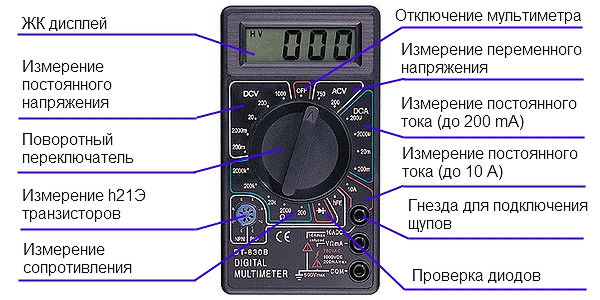
How to check the capacity of a car battery with a multimeter?
The need to check the capacity of a car battery arises, as a rule. In the event that the engine cannot be started. If you are faced with the need to carry out such a procedure, you should carry out the final diagnosis, which occurs using the boot fork. On a car battery without load, the capacity level is about 12 volts, and under load this figure will not be more than 11 volts.
So, if you decide to use a battery tester and measure the capacity parameter, it will be useful for you to know some points:
- In the event that the battery is fully charged, the electrolyte density in the system should be about 1.24 g/cm3.
- When the electrolyte density indicator drops by 0.04, this will indicate that the battery is discharged by 25%.
- In the event that the density parameter decreases even more - by 0.08 g / cm3, this will indicate that the battery charge has decreased by 50%.
Diagnosing the battery charge level using a tester is to measure the voltage at the battery terminals if there is no load on the on-board network. If the device's charge level is full, then during diagnostics, the resulting parameter will be equal to 12.6 volts. But if the multimeter showed that the charge is 12.2 volts, then this indicates the need for a charging procedure.

Verification methods
How to check the battery at home on your own? There are several methods for diagnosing.
The first is the control discharge method, it is carried out in several stages:
- First, the device must be fully charged and discharged, while the power or current parameter must be maintained.
- When the minimum allowable voltage is reached, the discharge should be stopped and the time recorded. The results of the control discharge should be compared with technical features battery, as well as the results of previous tests, if any.
- The longer the battery will be discharged to the load, the higher its capacity will be, respectively, and the result of the diagnosis.
But this option does not suit us, because it requires the right approach and time for the implementation of diagnostics. Therefore, we will use a conventional multimeter. The load parameter in this case should be such that this load is able to take half the current necessary for the operation of the battery. This method of verification is carried out only if the level of charge of the device is full (the author of the video is the Accumulator).
It should be noted that it is quite possible to use an ordinary incandescent lamp for the load - if you notice that the light it emits is very dim, then this indicates a discharge of the device. In the event that, as a result of the test, the multimeter showed a parameter of 12.4 volts, this indicates a good battery capacity, that is, the device is fully operational.
Battery voltage measurement
The voltage level at the battery terminals is usually no more than 24 volts, so the motorist does not need to follow safety measures. To obtain the most accurate test results, it is first necessary to measure the constant and alternating current. The measurement procedure is carried out using the leads located on the end of the device. The multimeter itself should be connected to the contacts, and then put the device in AC mode.
As practice shows, proper use will allow to increase the service life of the battery. If the ignition in your car is turned off, try to use sources of current consumption (headlights, car radio and other gadgets) to a minimum, otherwise this will lead to accelerated discharge.
Despite the fact that the battery charges itself when the car is parked, before turning off the car, you must turn off all consumers. Before leaving the car in the garage or parking lot, turn off the headlights, close the windows with power windows (if they are electric), turn off the music. Before turning off the engine, let it run for a few minutes with the power consumers turned off - this will allow you to replenish the charge.
Features of the operation of acid batteries
In order for the battery to serve properly and for a long time, you need to monitor its condition, regardless of its type, be it a battery for a car, an uninterruptible power supply, and others.
For example, if you do not monitor the condition of a car battery, then its life is halved, from 6 years to 3. Of course, if you have enough money and you are just a rider, then the battery can be changed every 2-3 years. To ensure that batteries do not give you trouble while driving, you must know the remaining battery capacity for timely replacement.
The battery capacity is affected by the charge current, charge time, and the degree of sulfation of the plates. Although batteries for cars are starter batteries, that is, they are designed for a starter current of 200 - 300 A, frequent starting of the starter reduces its service life. For example, if you use car starter batteries in equipment with a constant load, their service life increases to 14 - 16 years.
Acid batteries are usually charged with a current equal to 10% of their capacity. For a capacity of 60 Ah, the recommended charge current according to the instructions is 6 A. However, the quality of the charge, which is expressed in an increase in capacity, is achieved by a small charge current of up to 1 A. At this current, the battery plates are more fully saturated with charge.
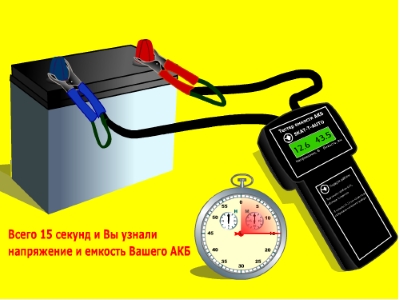
The disadvantage of this method is the increase in charge time. If necessary, the charge current can be increased to 20 A for car batteries, the main thing here is not to miss the time when the battery starts to heat up quickly. It is recommended to train acid batteries once every six months to clean the plates from sulfation (crystals of lead salts) and increase battery capacity.
Training consists of a three-time charge-discharge cycle. The battery is fully charged, then discharged to 12 V. Such training promotes the dissolution of lead salt crystals on the plates, and accordingly increases the capacity of the acid battery.
The battery capacity indicates how much current the battery can supply to the load over a certain period of time. Take a car battery with a capacity of 60 Ah. Such a battery can supply a current of 60 A for 1 hour, or 6 A for 10 hours. Battery capacity is calculated by the formula: E(A)=I(A)*T(h) where,
E is the battery capacity in Ah, I is the current in amps, T is the battery discharge time in hours.
One multimeter can determine the capacity of any battery. There are several ways to measure battery capacity.
- Checking the battery capacity with a multimeter.
- Checking the state of charge of the battery with a load plug.
- Checking the battery capacity with a SKAT-T-AUTO tester or similar.
- Battery capacity test by electronic load.
It is possible to determine the battery capacity with one multimeter by the voltage value. However, this value will be very approximate and not entirely reliable. With a multimeter and one rheostat, you can more accurately calculate the battery capacity. This calculation will be more complete and reliable.
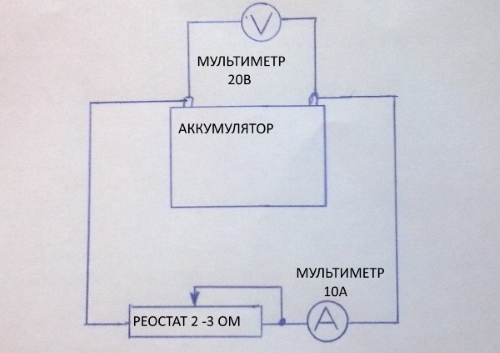
On the rheostat, a resistance of 2-3 ohms is set. Connect it to the battery terminals through a multimeter, which is turned on in the current measurement mode of 10 A of the corresponding polarity and measure the current through the rheostat. If there is only one multimeter, it is turned off, the operating mode is set to measurement constant voltage 20 V and connected to the battery terminals.
A rheostat is connected to the same terminals. They note the time, and wait for several hours until the multimeter shows 12 V. That's it, the process of measuring the battery charge with a multimeter is completed. Now we multiply the time by the current and find the capacity of the battery.
A more accurate result can be obtained if you use two multimeters or a multimeter and a 10 A ammeter. In this option, the discharge current is measured every hour and recorded. As the battery discharges, the current will decrease. At the end of the experiment, the average value of the discharge current is found (the currents are summed up and divided by the number of measurements), then the average discharge current is multiplied by the discharge time.

The degree of charge of the battery at idle after parking the car for 24 hours
The SKAT-T-AUTO battery capacity tester gives results in 15 - 20 seconds. His testimony is not of high accuracy, approximate. High results in accuracy when measuring battery capacity (at a discharge current of 5A - 1.2%) can be obtained by working with an electronic load.
An electronic load is useful for auto electricians and those who like to experiment with batteries, train them and calculate the exact battery capacity. For training, a discharge current of 4 - 6 A and a voltage of 12V are set on the electronic load, reaching which the sound signaling of the end of the battery discharge is turned on.
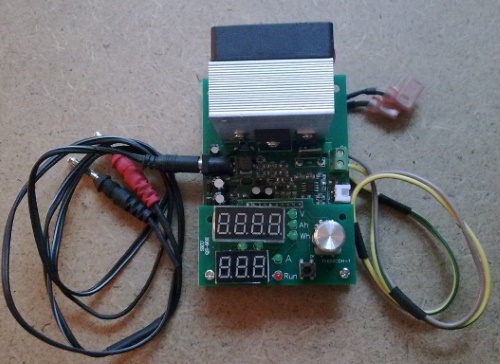
Electronic load to test the capacity of all types of batteries
Below 12 V, this is already a deep discharge and it is not recommended to discharge further, since there is a possibility of destruction of the plates. Next, the battery is charged with a conventional charger up to 14.2 V, after charging the battery, the discharge process is repeated again.
At the end of the workout, charge the battery, give 2 hours of rest and measure the battery capacity with an electronic load. To measure the capacitance in the A⋅h mode, set the voltage to 12 V and the discharge current to 4-6 A. An audible alarm will notify you of the end of the process. Next, the battery is charged again and installed on the car. This electronic load checks any batteries with a voltage of 6, 12 and 24 V.
